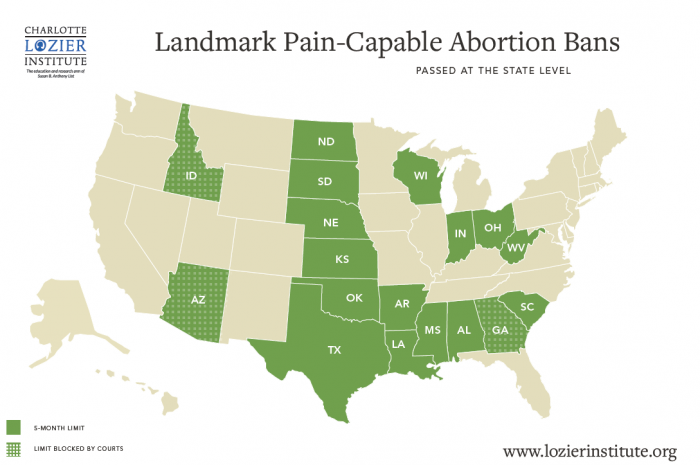On December 13, 2016, Ohio became the 18th state to pass a 20-week ban on abortion, after Gov. John Kasich, a Republican, signed the bill into law. As a graphic from the Charlotte Lozier Institute shows, Ohio joins 17 other states in passing this popular legislation.

Image via Susan B. Anthony List’s Facebook page.
While three of the bans are currently blocked by courts, a majority of the 18 states are able to enforce their bans on abortions committed on babies already halfway through pregnancy and who science and doctors say can unequivocally feel pain at this point in their development. (Research shows that pain may be felt as early as 5.5 weeks.) The Charlotte Lozier Institute has also done a comprehensive and extensively researched report on the subject of fetal pain and suffering.
The pro-life movement was dealt a setback with the U.S. Supreme Court‘s June decision in Whole Woman’s Health v. Hellerstedt. Hellerstedt struck down Texas’ commonsense abortion safety regulation law known as HB 2, including a requirement that abortionists have hospital admitting privileges and that abortion facilities be held to the same standards as ambulatory centers. Such a decision was handed down even after the abortion facility in the case had been caught with several violations. These regulations are widely supported by Americans across all demographics and beliefs.
The good news, however, is that Texas’ 20-week abortion ban, which was also part of HB 2, still stands today, as it wasn’t even challenged. These bans are the ones “Big Abortion is afraid to challenge,” as Texas Right to Life says.
The Knights of Columbus/Marist, which commissioned the poll that came to the findings on the popularity of abortion facility regulations, also found that Americans — once again, across varying demographics and beliefs — agree with a 20-week ban on abortion.
Brutally taking the life of a pain-capable human being, who is also innocent, defenseless, and vulnerable, is a losing issue for the abortion movement. Yet its lobby still tries to justify these late-term abortions. When such a ban at the federal level was being debated in January 2015, Planned Parenthood president and CEO, Cecile Richards, scoffed at the attempt, claiming Americans didn’t care about the issue. Her organization and others, including NARAL Pro-Choice America, not only advocate for these gruesome abortions, but also hide behind the false claim that late-term abortions are only performed for reasons such as fetal abnormalities diagnosed late in pregnancy.
The reality is far different than what Big Abortion wants Americans to believe. Research from Live Action News’ Sarah Terzo shows that most women do not get late-term abortions because their life or health or that of their baby is at risk. In fact, “30% of women who came in for a second-trimester abortion had had at least one previous second-trimester abortion…[and] the statistics indicate that some women may be using [late-term] abortion for birth control.”
Even the pro-abortion Guttmacher Institute‘s research demonstrates that fetal abnormalities and the mother’s life and health are not the most common reasons for late-term abortion. As Terzo reports:
[T]he Alan Guttmacher Institute…conducted a study of hundreds of women who had second-trimester abortions (the second trimester ends at 27 weeks). It came up with the following results:
68% had no pregnancy symptoms
58% Didn’t confirm the pregnancy until the second trimester
45% had trouble finding abortion provider
37% unsure of date of last menstrual period
30% had difficulty deciding on abortion
Believe it or not, the study sample did not contain a single case of abortion for health reasons.
That 18 states have passed bills banning abortion so late in term — at a point in time where viability continues to move up — is a refreshing look at what is to come. Eighteen is almost halfway there. This success also may bring about hope and encouragement for those looking for a federal ban on late-term abortions. Such legislation has been passed by the U.S. House of Representatives and been considered by the U.S. Senate, both of which will remain pro-life for 2017, following the 2016 elections. President-elect Donald Trump has also pledged support for such a ban.
The United States is currently just one of four nations in the world which allows for elective abortion up until birth. Late-term abortion bans — and the current trend among states and on a national level — is a step in the right direction to changing that.







